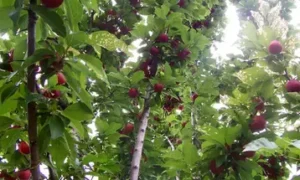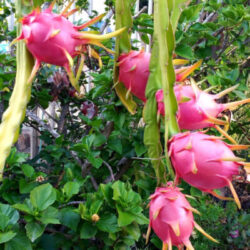
If you love blackberries and want to cultivate them yourself, How to build a trellis for blackberries is a terrific way to support your plants and promote their robust development. Your plants will stay straight, won’t droop, and harvesting will be lot simpler with a trellis.
Even though you can buy a trellis that has already been made, building your own can be a rewarding and enjoyable project. We’ll walk you through the steps of creating a blackberry trellis in this guide so you may take advantage of a plentiful harvest of these delectable fruits.
Introduction to Blackberry Trellis: Why it’s important
A blackberry trellis is a structure that supports blackberry plants as they grow, providing them with stability, proper air circulation, and adequate sunlight. Creating a trellis for your blackberries can not only improve the health and productivity of your plants, but it can also make harvesting easier and more efficient. Without a trellis, blackberry canes can become tangled and crowded, making it difficult to harvest the fruit and maintain the overall health of the plant. In this article, we will discuss how to make a trellis for blackberries and why it is an important investment for any home gardener looking to grow these delicious and nutritious berries.
Also Read: Are kiwi Fruits Acidic or Alkaline
Materials Needed: Tools and Supplies
Before starting the construction of a blackberry trellis, it is important to gather all the necessary materials and tools. Here is a list of some of the essential items you will need:
- Wood or metal posts: These are used to support the structure of the trellis. Wooden posts are a popular choice as they are affordable, easy to work with, and can be painted or stained to match your garden’s aesthetic. Metal posts are more durable and resistant to rotting and can be a good choice for larger trellises.
- Wire or twine: This is used to create the structure of the trellis. Galvanized wire or heavy-duty twine are good choices as they are strong and can withstand the weight of the blackberry canes.
- Fasteners: Screws, nails, or brackets are used to attach the wire or twine to the posts. Choose fasteners that are strong and durable and can withstand outdoor elements.
- Post-hole digger: This is used to dig holes for the posts. A manual post-hole digger can be used for smaller trellises, but a powered auger is recommended for larger projects.
- Level: This is used to ensure that the trellis is level and even.
- Saw: A saw is necessary to cut the posts and wire or twine to the appropriate length.
- Drill: A drill is needed to attach the fasteners to the posts.
- Gloves and safety glasses: These are important safety items to protect your hands and eyes while working.
By gathering all the necessary materials and tools, you will be well-prepared to construct a sturdy and functional blackberry trellis.
Choosing the Right Location for Your Trellis
Choosing the right location for your blackberry trellis is important for the health and productivity of your plants. Here are some factors to consider when selecting a location:
- Sunlight: Blackberry plants require at least six hours of direct sunlight per day to thrive. Choose a location that receives full sun for the majority of the day.
- Soil: Blackberry plants prefer well-drained soil with a pH between 5.5 and 6.5. Avoid locations with heavy clay or poorly draining soil.
- Space: Blackberry plants can grow quite large, so choose a location with enough space to accommodate the size of your trellis and the number of plants you plan to grow.
- Access to water: Blackberry plants require consistent moisture, so choose a location that is easily accessible to a water source.
- Protection from wind: Strong winds can damage blackberry canes, so choose a location that is sheltered or plan to erect windbreaks.
- Accessibility: Choose a location that is easily accessible for pruning, harvesting, and maintenance.
Once you have selected a suitable location, mark the area where you plan to install your trellis and make sure there are no underground utilities or obstacles that could interfere with the installation. With a well-chosen location, your blackberry trellis will provide the optimal growing conditions for healthy and productive plants.
AlsO Read: is Cedar Mulch Good for blackberries?
Designing Your Blackberry Trellis: Types and Styles
When designing your blackberry trellis, there are several types and styles to consider. Here are some popular options:
- T-post trellis: This type of trellis consists of metal T-posts driven into the ground and wire strung between them. This is a simple and affordable option that works well for small-scale blackberry plantings.
- Cattle panel trellis: This trellis is made by attaching metal cattle panels to wooden posts. The panels provide a sturdy support structure, and the wide spacing between the wires allows for easy access to the blackberry canes.
- V-trellis: This style of trellis consists of two wooden posts set at an angle and wire or twine strung between them in a V-shape. This provides a sturdy support structure and allows for easy access to the canes.
- Geneva trellis: This is a more complex trellis design that features a series of horizontal wires or twines attached to wooden posts. This allows for precise training and pruning of the blackberry canes and maximizes the amount of fruit produced.
When choosing a trellis style, consider the size and layout of your garden, the number of blackberry plants you plan to grow, and your personal preferences. Regardless of the style you choose, make sure the trellis is sturdy and strong enough to support the weight of the blackberry canes as they grow and produce fruit.
Also Read: Is coconut Water Acidic? All you need to know
How To Make A Trellis For Blackberries: Step-by-Step Instructions.
Building a blackberry trellis can be a fun and rewarding project for any gardener. Here are some step-by-step instructions to guide you through the process:
Step 1-Measure and mark the location for your trellis
Use stakes and string to mark the location of your trellis. Consider the space needed for the size of your trellis and the number of blackberry plants you plan to grow.
Step 2-Dig post holes
Use a post-hole digger to dig holes for your posts. Make sure the holes are deep enough to support the height of your trellis and the weight of the blackberry canes.
Step 3- Set posts
Insert the posts into the holes and backfill with soil. Use a level to ensure that the posts are straight and even. Tamp the soil around the posts to ensure they are secure.
Step 4- Attach wires or twine
Attach the wire or twine to the posts using screws, nails, or brackets. Space the wires or twines evenly, leaving enough room for the blackberry canes to grow and produce fruit.
Step 5- Train the canes
Once the trellis is complete, begin training the blackberry canes to grow along the wires or twines. Gently bend the canes and tie them to the wires or twines using plant ties or twine. Make sure the canes are evenly spaced and not too crowded.
Step 6 – Prune regularly
Regular pruning is essential for maintaining the health and productivity of your blackberry plants. Prune the canes to remove any dead or diseased wood and to maintain the desired shape and size of the plant.
By following these step-by-step instructions, you can create a sturdy and functional trellis for your blackberry plants. With proper care and maintenance, your trellis will provide the optimal growing conditions for healthy and productive blackberry canes.
Also Read: how to Keep squirrel Out of trees
Planting Your Blackberries: Tips and Tricks
Planting blackberries is a crucial step in establishing a healthy and productive garden. Here are some tips and tricks to ensure your blackberry plants get off to a good start:
- Choose healthy plants: Purchase blackberry plants from a reputable nursery or garden center. Look for plants that are at least one year old, have healthy foliage, and a well-developed root system.
- Plant at the right time: Blackberries should be planted in late winter or early spring, when the soil is moist and temperatures are cool. Avoid planting in the heat of summer or during periods of drought.
- Prepare the soil: Blackberries prefer well-drained soil with a pH between 5.5 and 6.5. Add compost or aged manure to the soil before planting to improve soil structure and fertility.
- Plant at the right depth: Dig a hole deep enough to accommodate the entire root system of the blackberry plant. The base of the plant should be level with the surrounding soil.
- Space plants properly: Blackberry plants should be spaced three to four feet apart in rows that are six to eight feet apart. This will allow for proper air circulation and prevent overcrowding.
- Water regularly: Blackberry plants require consistent moisture, especially during the first year after planting. Water deeply once or twice a week, depending on rainfall.
- Mulch around plants: Apply a layer of organic mulch, such as straw or wood chips, around the base of the blackberry plants. This will help retain moisture in the soil, suppress weeds, and regulate soil temperature.
- Provide support: As the blackberry canes grow, provide support by tying them to the trellis wires or twines. This will prevent the canes from flopping over and breaking.
By following these tips and tricks, you can ensure that your blackberry plants are off to a good start and will provide you with a bountiful harvest for years to come.
Also Read: What Is the Best mulch For Blackberries
Training Your Blackberries to Climb the Trellis
Training your blackberries to climb the trellis is an essential step in creating a productive and healthy garden. Here are some tips for training your blackberries to climb the trellis:
- Start early: Begin training your blackberry canes to climb the trellis as soon as they are long enough to reach the wires or twines. This will help prevent the canes from becoming tangled and difficult to manage.
- Use soft ties: Tie the canes to the trellis using soft ties, such as plant ties or twine. This will prevent damage to the canes and allow for easy adjustments as the plant grows.
- Train the canes in a fan shape: Blackberry canes should be trained in a fan shape, with the canes fanning out along the wires or twines. This will provide maximum exposure to sunlight and airflow, which is essential for healthy growth and fruit production.
- Prune regularly: Regular pruning is essential for maintaining the health and productivity of your blackberry plants. Prune the canes to remove any dead or diseased wood and to maintain the desired shape and size of the plant.
- Remove side shoots: Blackberry canes will produce side shoots, or suckers, that grow from the base of the plant. Remove these side shoots as soon as they appear to prevent overcrowding and to ensure that the plant directs its energy towards fruit production.
- Check regularly: Check your blackberry plants regularly for signs of growth and adjust the ties as needed. Make sure the canes are evenly spaced and not too crowded.
By following these tips for training your blackberries to climb the trellis, you can create a healthy and productive garden that will provide you with a bountiful harvest of delicious blackberries.
Also Read: is Acai Acidic Or alkaline? All You should know
Maintenance and Care of Your Blackberry Trellis
Maintaining and caring for your blackberry trellis is essential for ensuring the health and productivity of your plants. Here are some tips for maintaining and caring for your blackberry trellis:
- Regularly check the wires or twines: Check the wires or twines that support the blackberry canes regularly for signs of wear and tear. Replace any damaged wires or twines to prevent the canes from falling or breaking.
- Prune regularly: Prune your blackberry plants regularly to maintain their shape and size, and to remove any dead or diseased wood. This will help promote healthy growth and fruit production.
- Fertilize annually: Blackberry plants require regular fertilization to maintain their health and productivity. Apply a balanced fertilizer, such as a 10-10-10 or 16-16-16 fertilizer, in early spring before new growth appears.
- Weed regularly: Keep the area around your blackberry trellis free of weeds to prevent competition for water and nutrients. Use a hoe or hand-pull weeds regularly.
- Mulch around plants: Apply a layer of organic mulch, such as straw or wood chips, around the base of the blackberry plants to help retain moisture in the soil, suppress weeds, and regulate soil temperature.
- Water regularly: Blackberry plants require consistent moisture, especially during the first year after planting. Water deeply once or twice a week, depending on rainfall.
- Monitor for pests and diseases: Keep an eye out for signs of pest or disease problems, such as leaf spots or spider mites. Treat any problems promptly to prevent them from spreading to the rest of the plant.
By following these tips for maintaining and caring for your blackberry trellis, you can ensure that your plants remain healthy and productive for years to come, providing you with a bountiful harvest of delicious blackberries.
Troubleshooting Common Blackberry Trellis Issues
Despite your best efforts, you may encounter some common issues with your blackberry trellis. Here are some tips for troubleshooting these issues:
- Canes falling off the trellis: If the blackberry canes are falling off the trellis, it may be because they are not tied securely enough. Use soft ties, such as plant ties or twine, and tie the canes to the trellis at regular intervals. You can also use trellis clips to hold the canes in place.
- Canes getting tangled: Blackberry canes can become tangled and difficult to manage if they are not trained early enough. To prevent this, start training the canes to climb the trellis as soon as they are long enough to reach the wires or twines.
- Canes not producing fruit: If your blackberry canes are not producing fruit, it may be because they are not receiving enough sunlight or nutrients. Make sure the canes are trained in a fan shape to maximize exposure to sunlight, and fertilize the plants regularly.
- Disease or pest problems: Blackberry plants can be susceptible to a variety of diseases and pests, such as powdery mildew, spider mites, or aphids. Monitor your plants regularly for signs of these problems, and treat them promptly using organic or chemical controls as appropriate.
- Broken or damaged wires or twines: If the wires or twines that support your blackberry canes become damaged or broken, replace them promptly to prevent the canes from falling or breaking.
By troubleshooting these common issues with your blackberry trellis, you can help ensure the health and productivity of your plants, and enjoy a bountiful harvest of delicious blackberries.
Also Read: how to Make Trellis for BlackBerries
Harvesting and Recipes.
After all your hard work, it’s finally time to enjoy the fruits of your labor! Here are some tips for harvesting and using your blackberries:
- Harvesting: Blackberries are ripe when they are fully black and easily detach from the plant with a gentle tug. Harvest your blackberries in the morning when they are cool and dry, and store them in a cool place until ready to use.
- Recipes: Blackberries are a versatile fruit that can be used in a variety of sweet and savory dishes. Try making blackberry jam, pie, cobbler, or sorbet. You can also add blackberries to salads, smoothies, or yogurt.
- Storage: Blackberries are delicate and can easily bruise or spoil if not handled properly. Store your blackberries in a single layer in a shallow container, and keep them in the refrigerator for up to three days. Alternatively, you can freeze your blackberries for later use by spreading them out on a baking sheet and freezing them until firm, then transferring them to a freezer-safe bag or container.
- Preserving: If you have an abundance of blackberries, consider preserving them for later use. You can make blackberry jam, jelly, or syrup, or dry them for use in teas or trail mix.
By following these tips for harvesting and using your blackberries, you can enjoy the delicious and nutritious fruits of your labor all season long.
Frequently Asked Questions on How to make A trellis for BlackBerry
Here are some frequently asked questions (FAQs) about making a trellis for blackberries:
What is the best time of year to make a blackberry trellis?
Answer: The best time to make a blackberry trellis is in late winter or early spring before the blackberry plants begin to grow.
How much space do I need between the trellis wires or twines?
Answer: The space between the wires or twines should be about 18-24 inches apart to allow room for the blackberry canes to grow and spread.
How deep should I bury the posts for my blackberry trellis?
Answer: The posts for your blackberry trellis should be buried at least 2 feet deep to provide adequate support for the trellis.
Can I use other types of plants with my blackberry trellis?
Answer: Yes, you can use other types of vining plants, such as grapes or kiwi, with your blackberry trellis. Just make sure they are compatible and won’t interfere with the growth of your blackberry plants.
How long does it take for blackberries to grow and produce fruit?
Answer: Blackberries typically take 2-3 years to begin producing fruit, but this can vary depending on the variety and growing conditions.
By following these FAQs, you can make sure you have all the information you need to successfully make and maintain a trellis for your blackberry plants.







